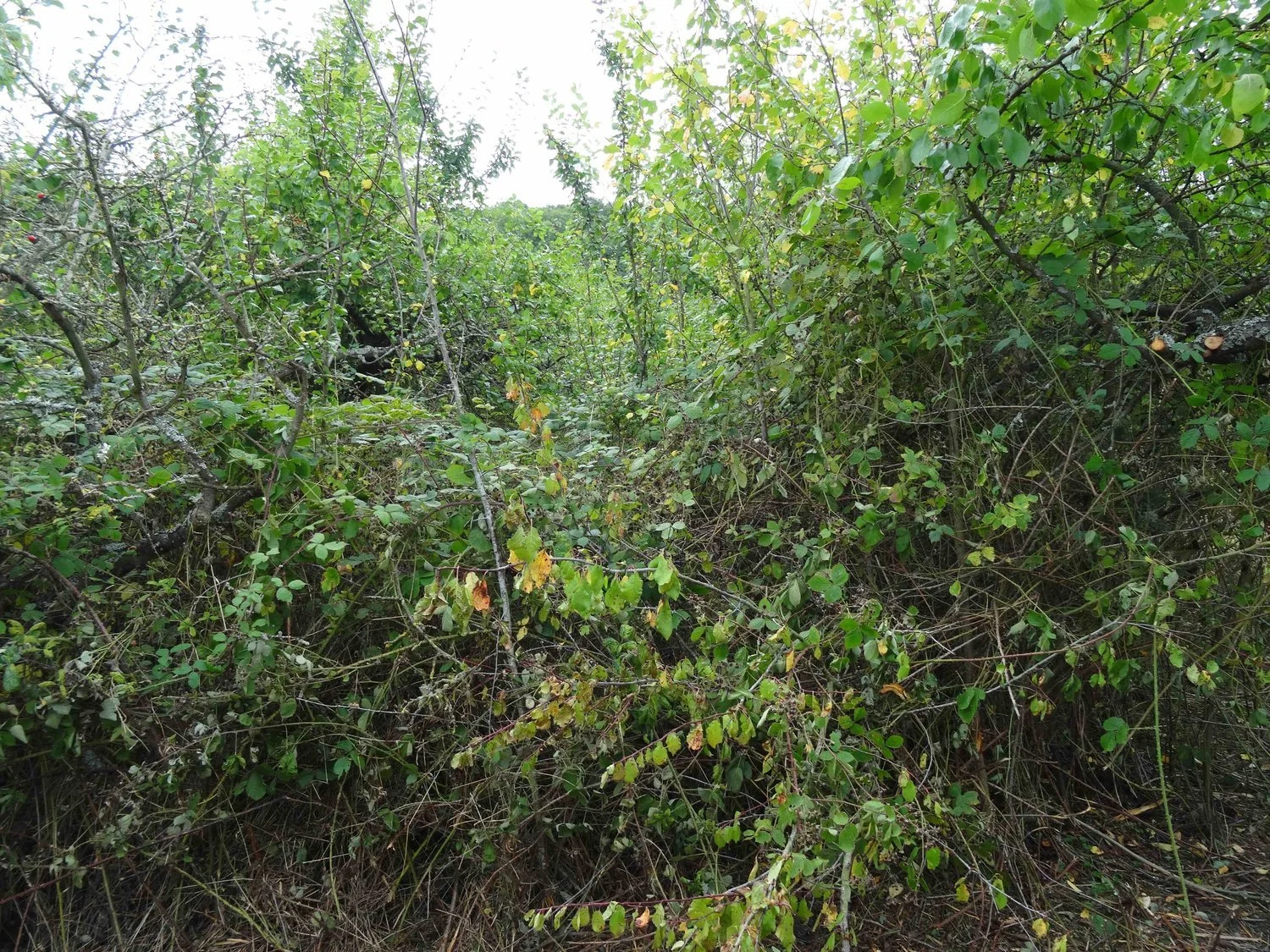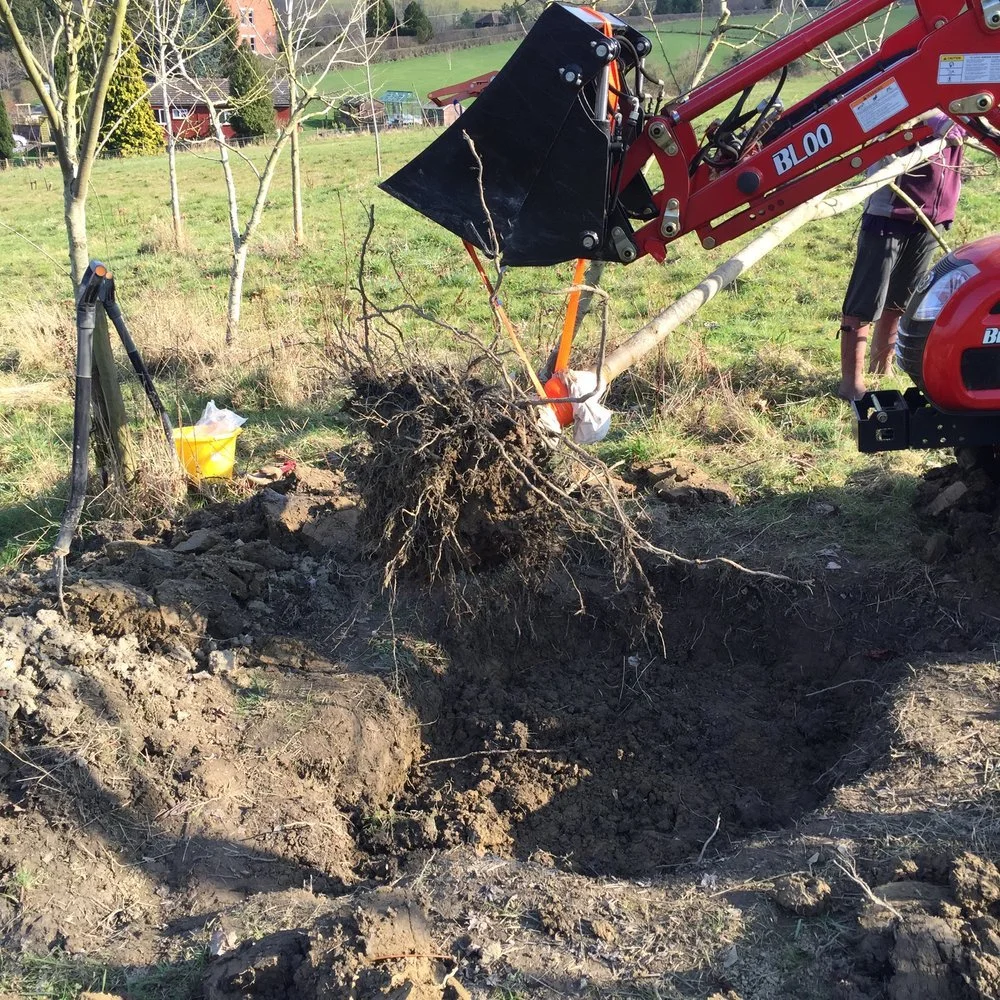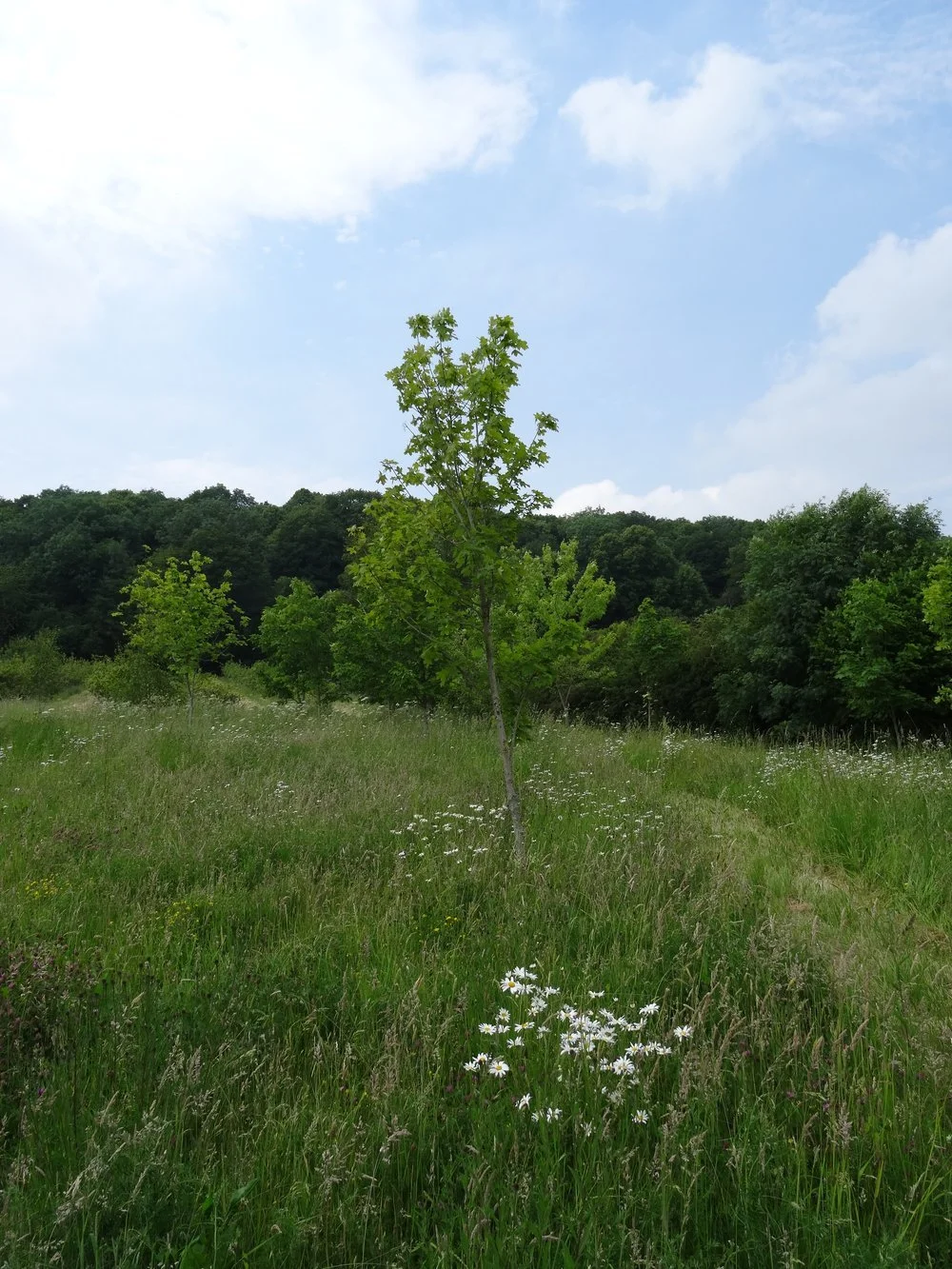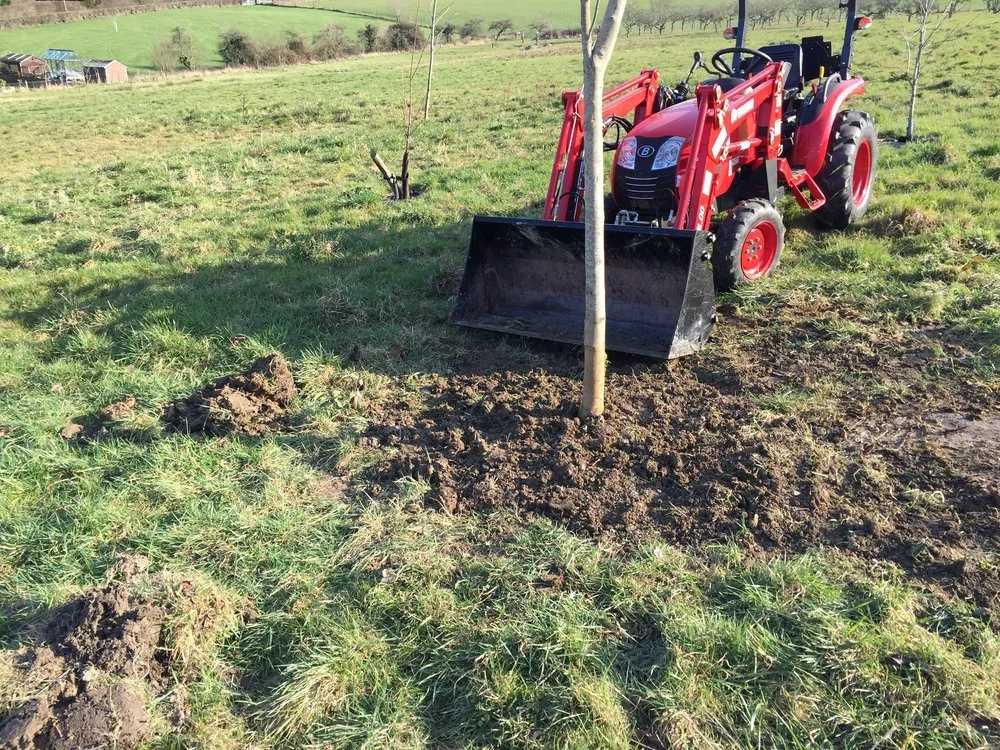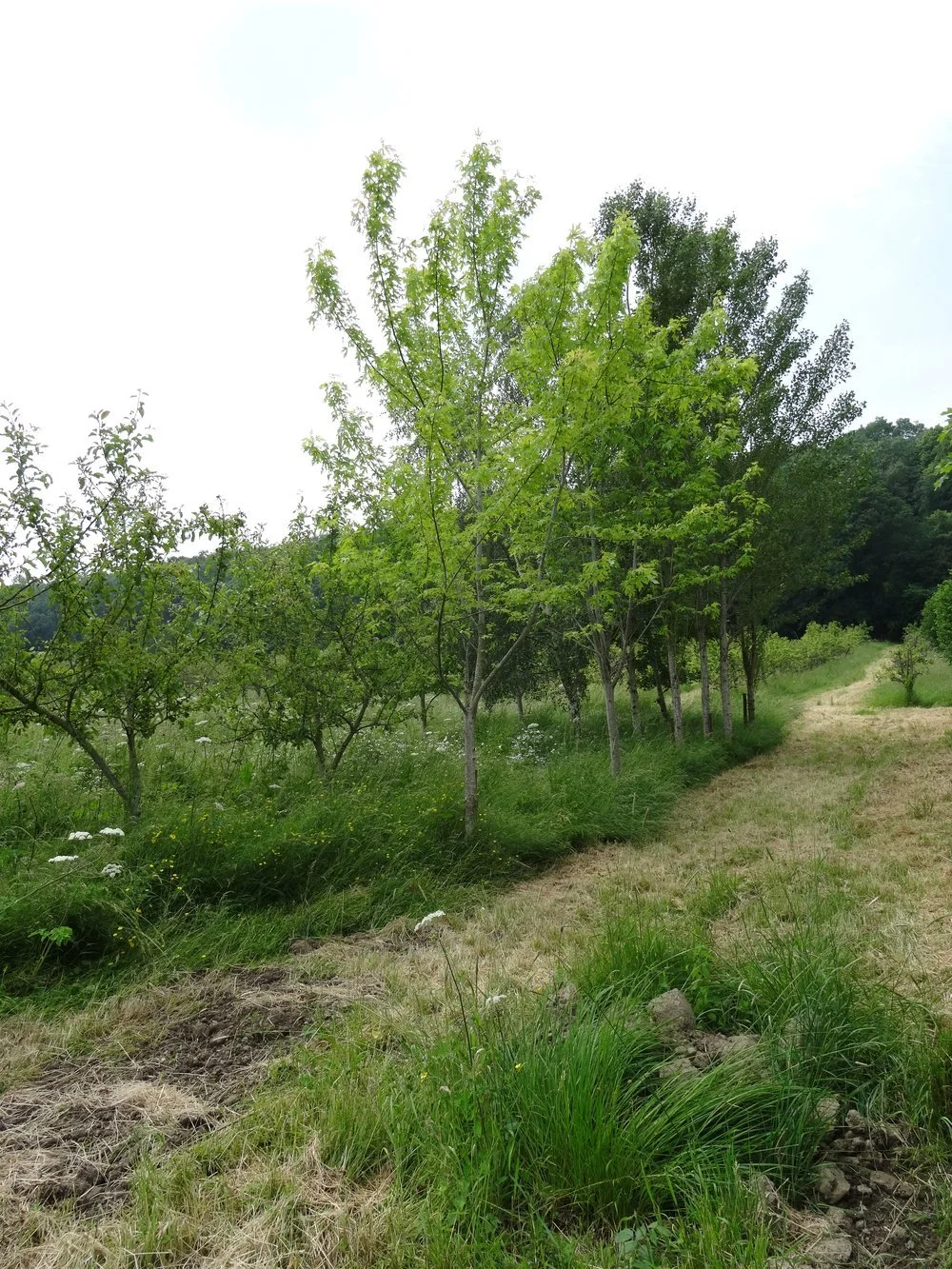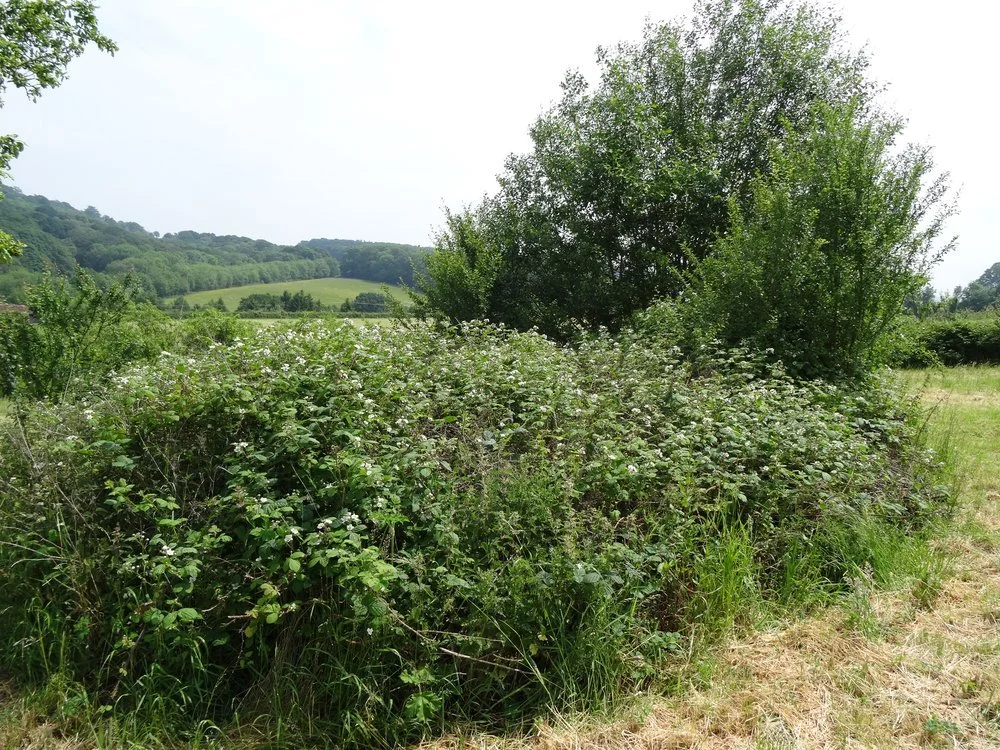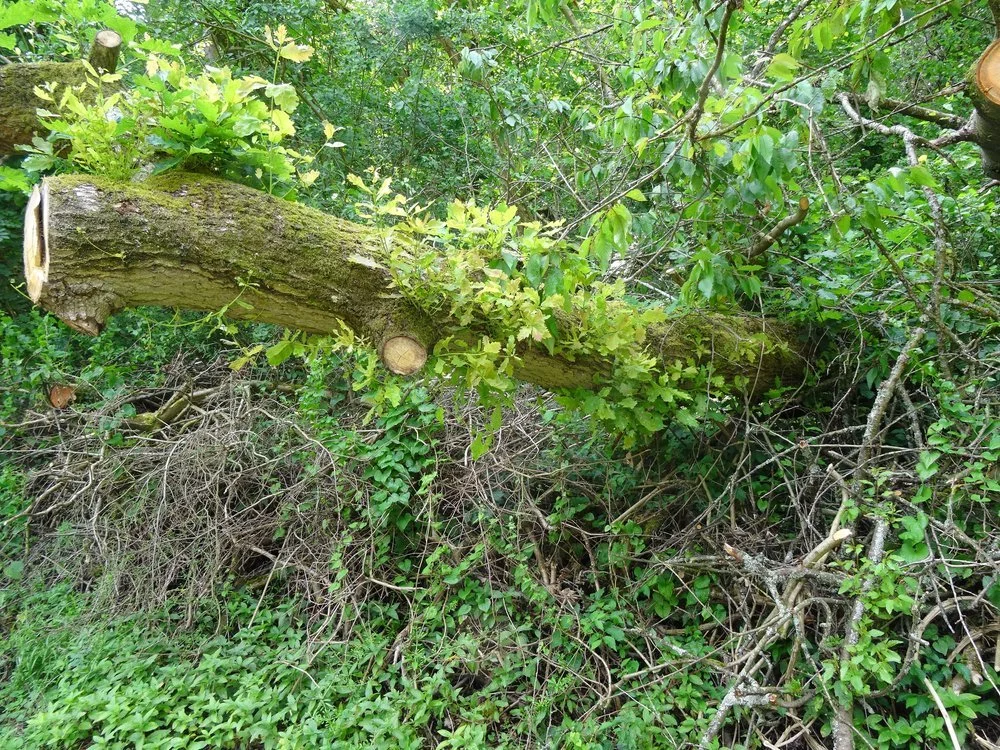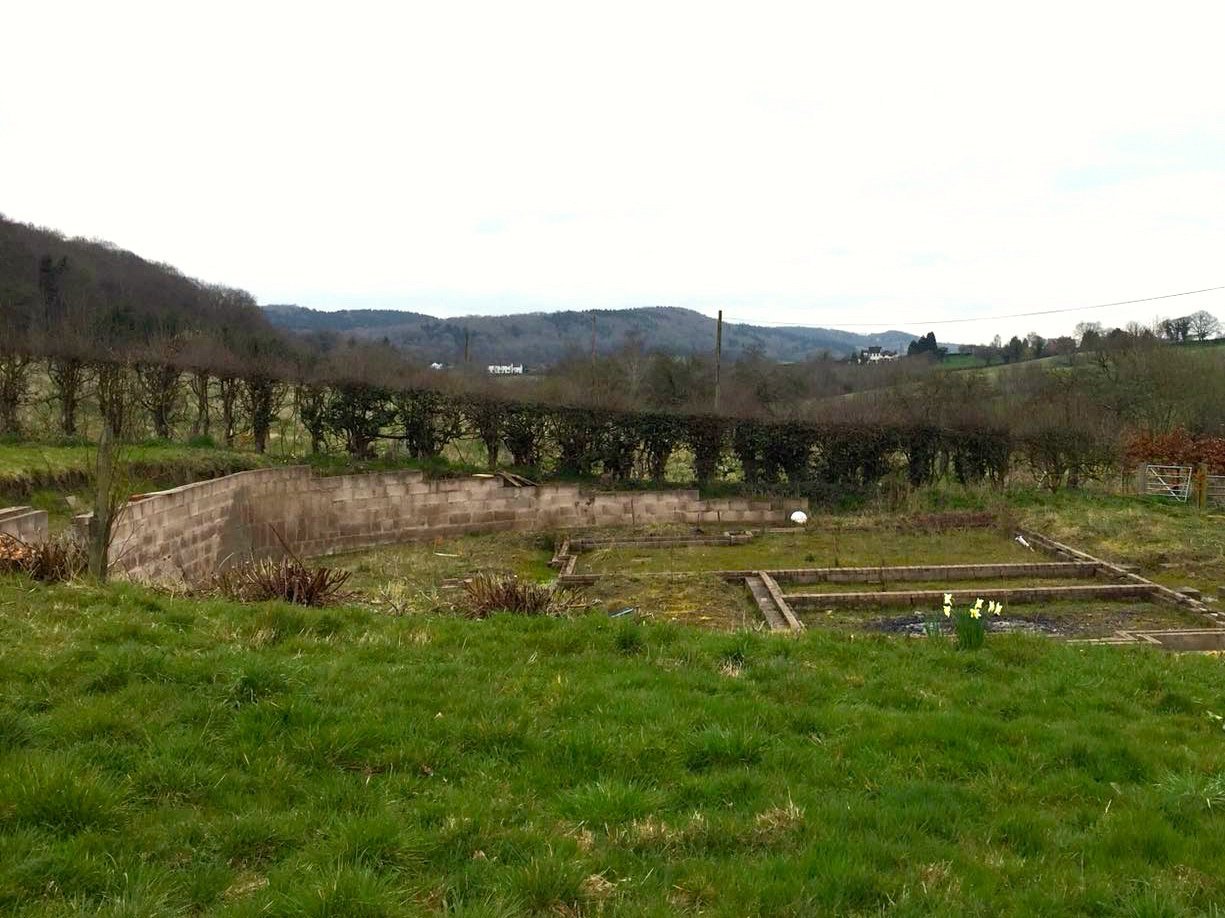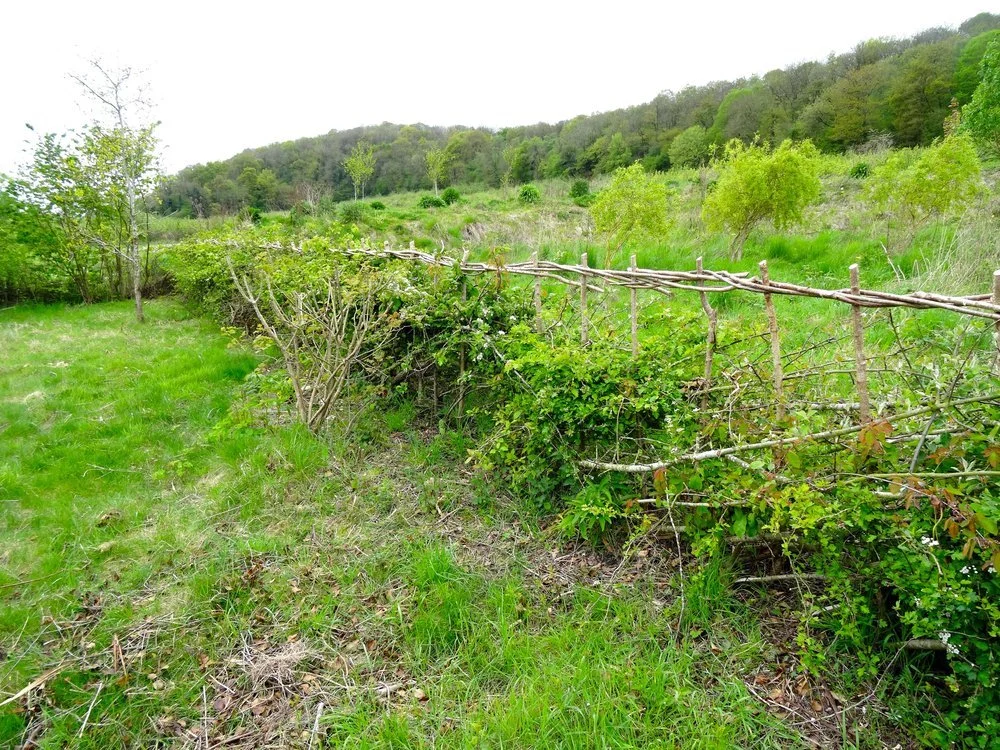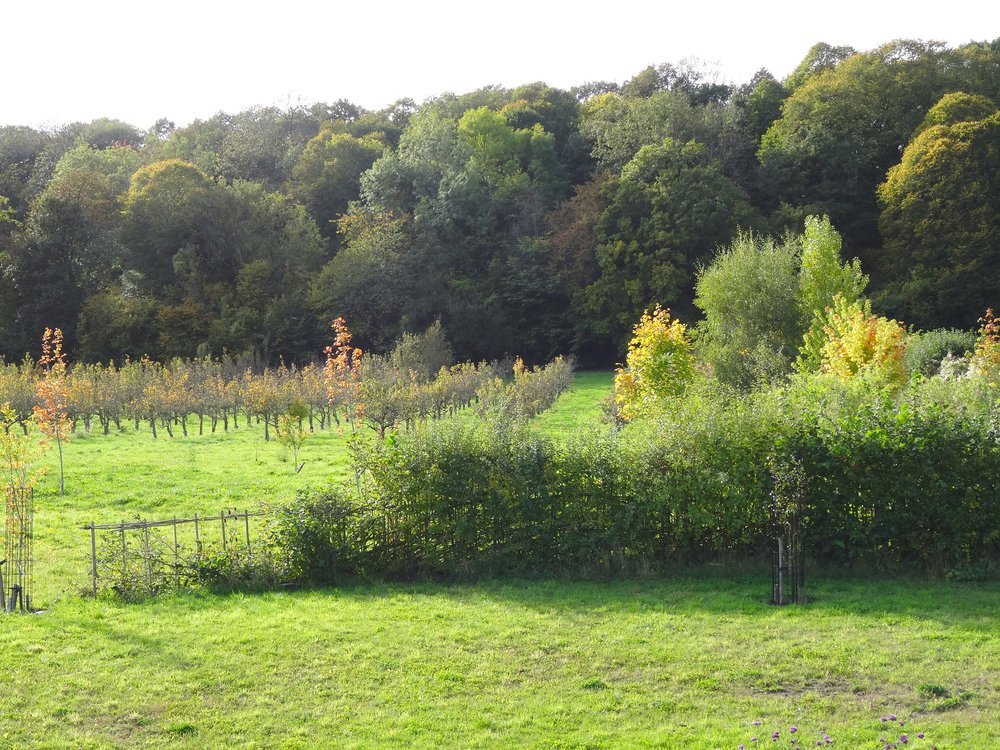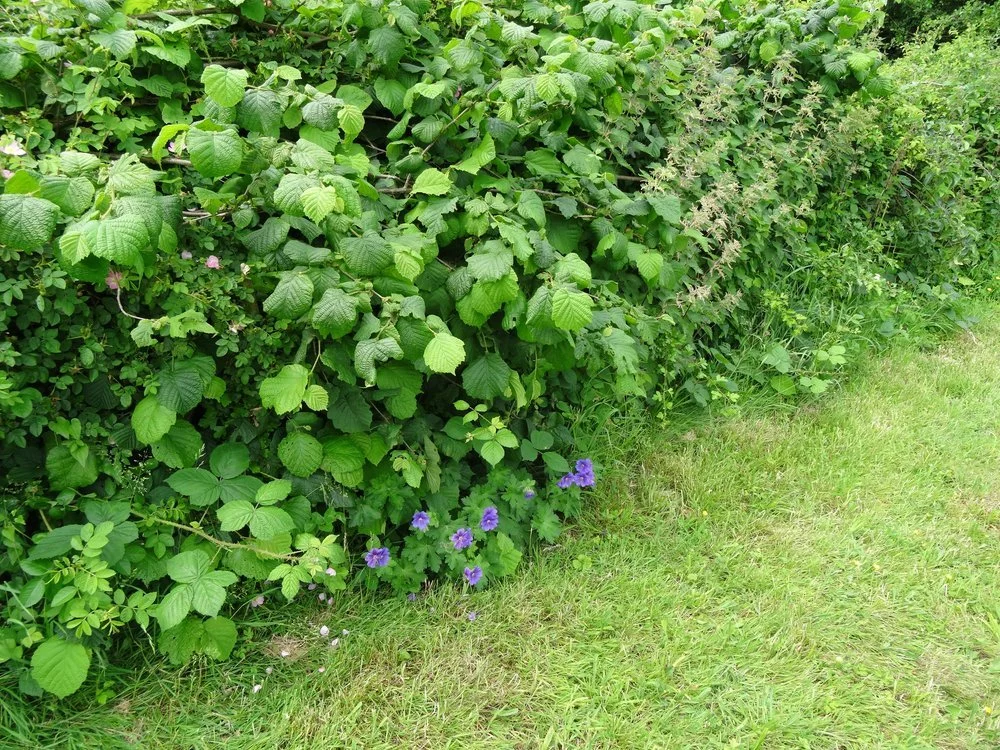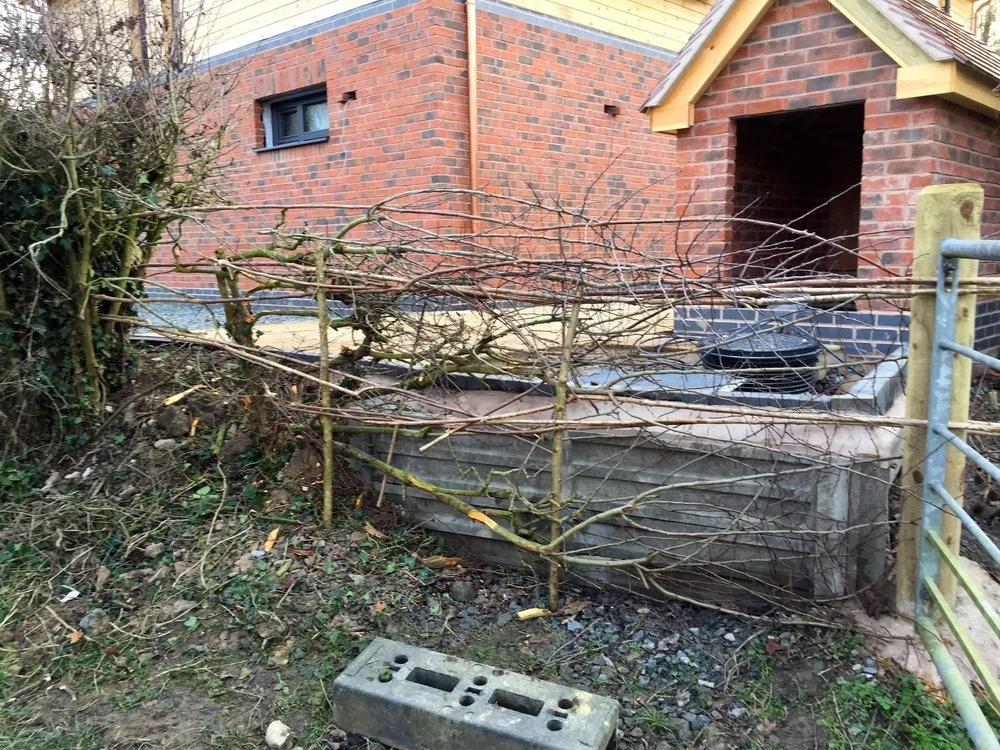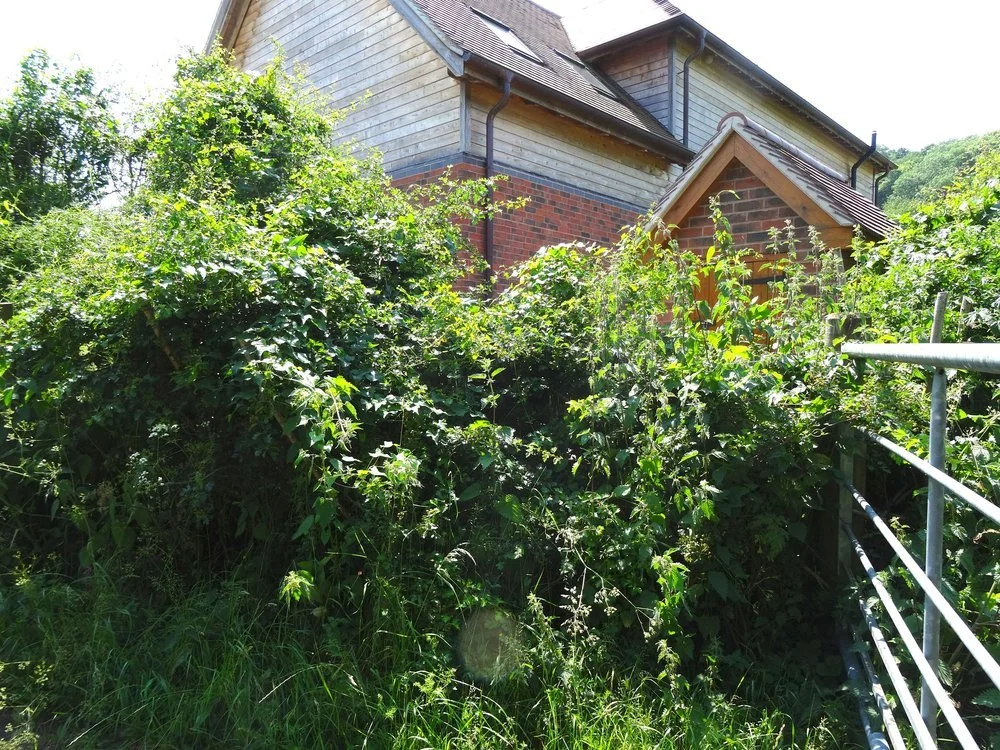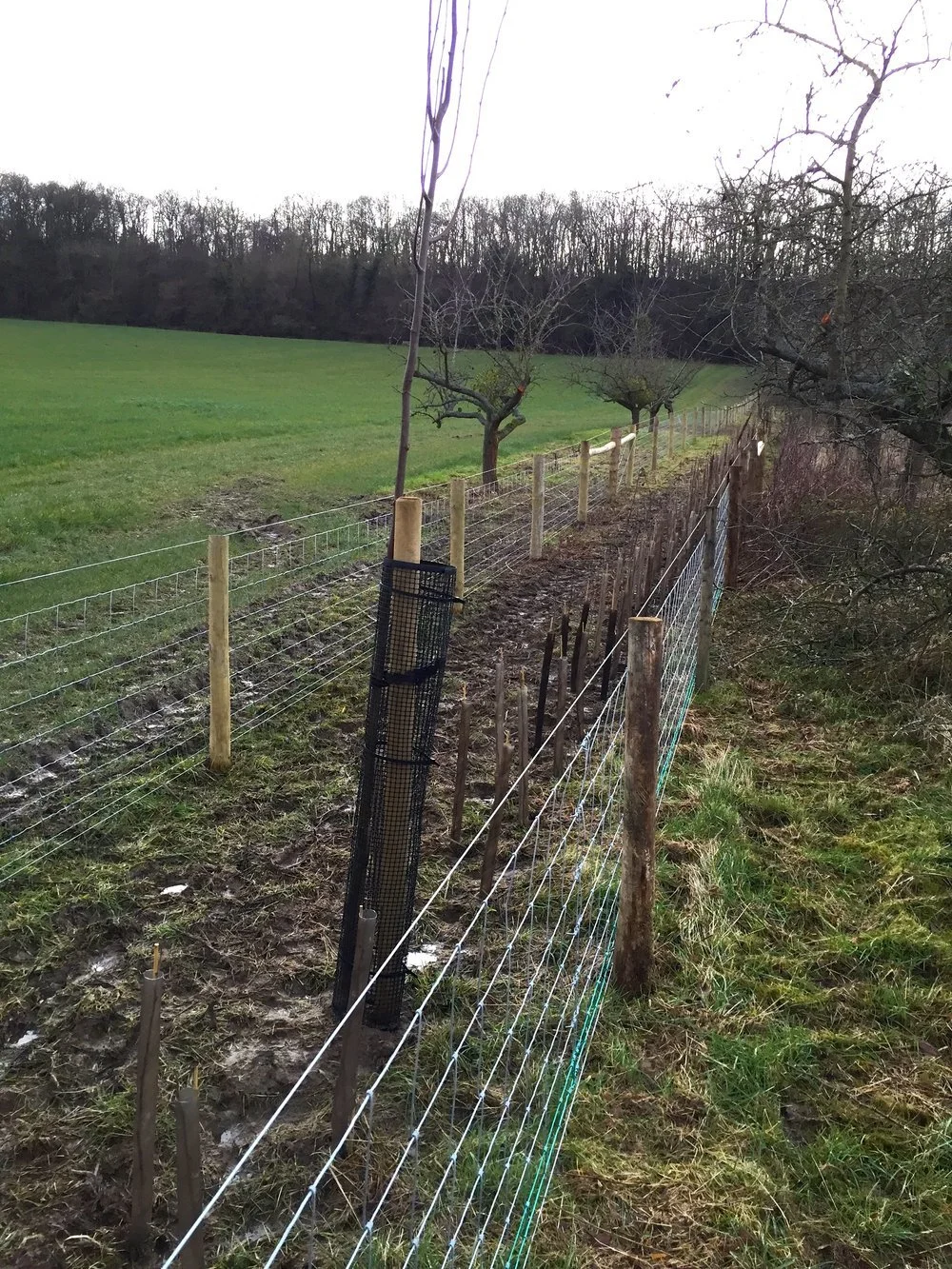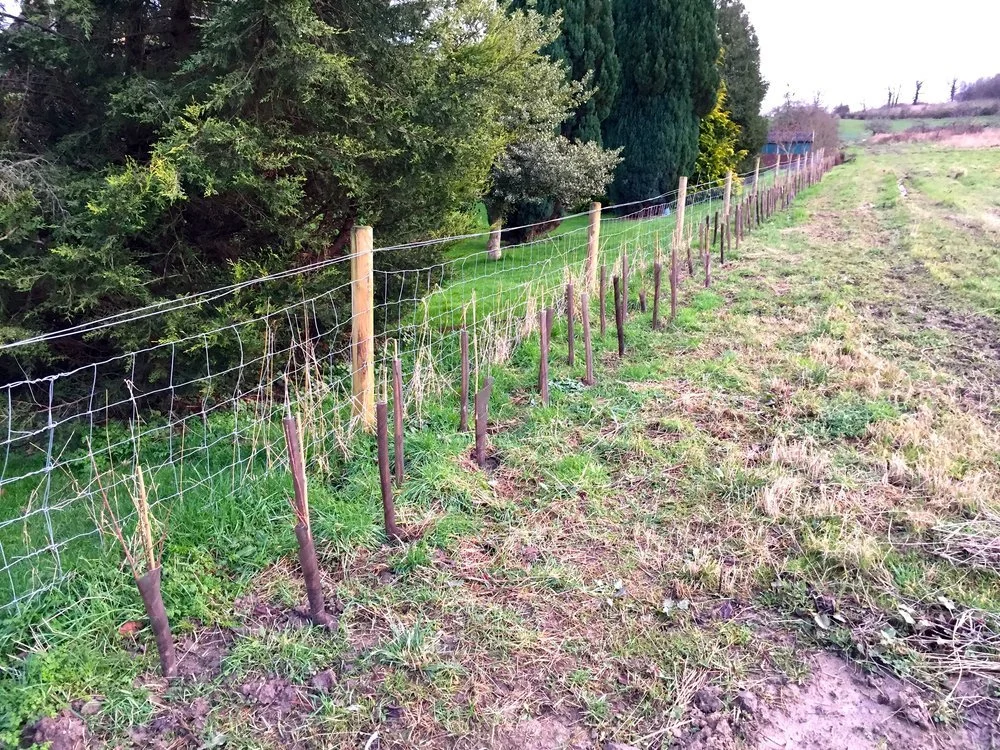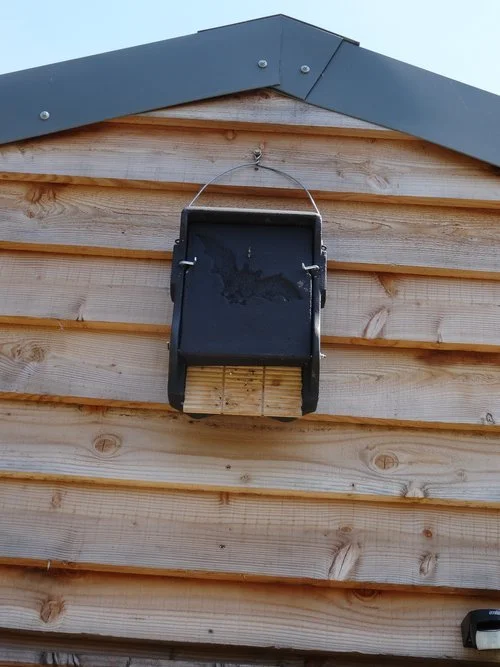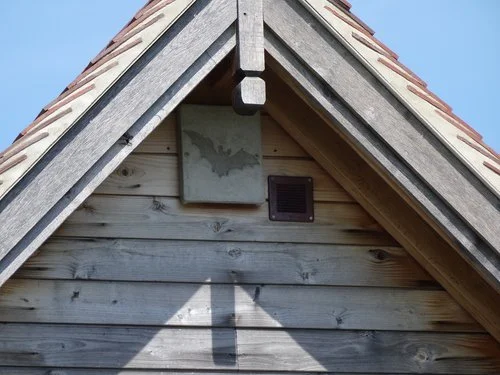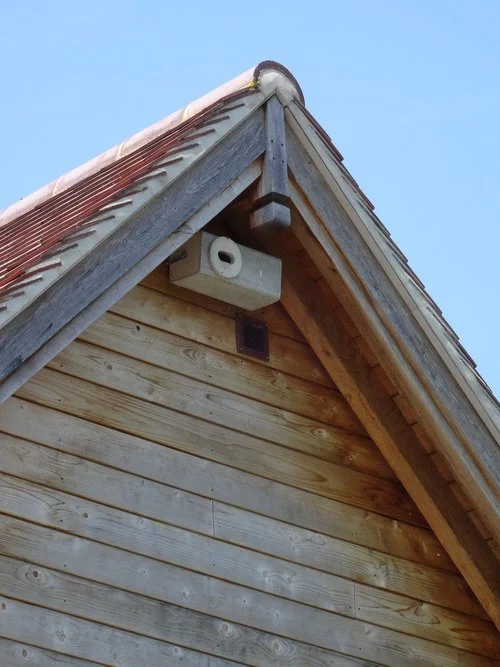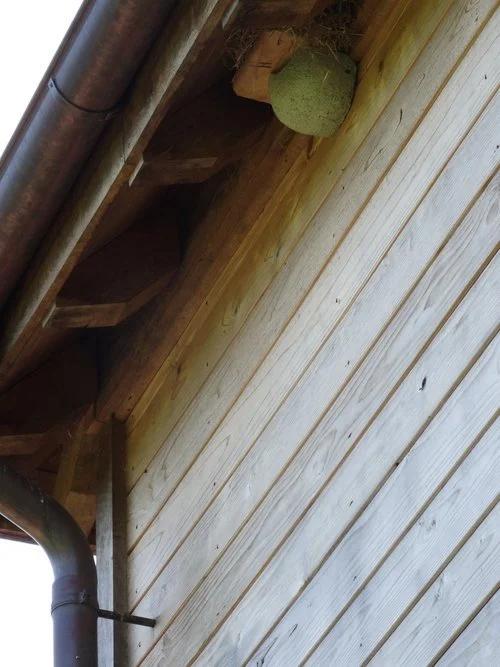Rewilding at Woodlands Malvern B&B
Woodlands is on part of a former fruit farm and our new-build plot came with a plum orchard of about 75 trees, a pear orchard with some 700 trees, a 4-acre field, an outbuilding and some 200m of elderly hedging. Little or nothing seemed to have been done to the orchards for perhaps eight years, which were consequently overgrown. And whilst the main hedge had been flailed it had very poor growth near the bottom and many of its large gaps had been ‘repaired’ with wire netting and metal grids. (You can see a picture of part of this hedge at the top of the Hedging section, below.) There was also a mixed native hedge that had been planted some 5-7 years previously at the top of the house garden area.
Our ‘rewilding’ project is a modest-scale attempt to support greater local biodiversity through native hedge restoration, creating a variety of habitats, encouraging more wild flowers in our field, and restoring two orchards. Rewilding to some means allowing Nature to take back land on a large-scale without Man’s interference. On this definition, our project is perhaps more about enabling ‘Nature recovery’ in our part of the Malvern Hills Area of Outstanding Natural Beauty (AONB).
The orchards
We were keen to make the orchards look (and be) cared for, requiring the removal of a multitude of self-sown saplings of various types (many as tall as the fruit trees), an abundance of brambles and chest-high grass. The pictures below give an idea of the scale of the task, stretching over much of some three acres.
Initially clearance was very slow work, using loppers, a pruning saw and a brush-cutter. However, things were transformed by getting a field and brush mower. This is rather like a walk-behind rotary lawnmower but with an 86cm blade and a 650cc 20HP engine. The manufacturer’s promotional video (above, right) shows it in action, and it doesn’t exaggerate!
We also planted a number of trees in the garden and orchards, including four oak saplings from a neighbour: the pear and plum trees will have a limited life so it is important that there are some mature trees to provide interest as well as habitats for the future.
In the two upper pictures below you can see parts of the cleared orchards. The grass requires cutting annually and although we’ve done a lot of pruning there is still much more to do.
Part of the plum orchard before clearance
Part of the pear orchard looking towards the Suckley Hills. Image credit: Mark Bolton Photography
Part of the plum orchard during clearance
Part of the plum orchard looking towards the Malvern Hills. Image credit: Mark Bolton Photography
Tree transplanting
When we bought the land we found a ‘nursery’ of trees of various types that had been planted just 1-2m apart in a long rectangle, presumably for subsequent and quick repositioning. Unfortunately, these had been left for several years and some (such as two horse chestnuts, two silver birches and several poplars) were just too well established to move. However, we were able to transplant ten of quite a few maples (of which only one died) and to plant some new trees to help break up the hard rectangle of the nursery and create a more natural look.
We undertook this in the winter months over three years; dug a large hole first for each tree to go into (getting a tree out can be tiring, so having the new hole ready helps a lot); and, crucially, preserved as much of the rootball and extended roots as possible and then planted this gently and firmed-in well-dug soil. The pictures below show the successful transplanting of one of the maples and the nursery rectangle now.
We also planted a number of new trees in the area to further break up the nursery rectangle, to create more interest (especially with autumn colours), and to provide additional habitats for wildlife.
Removing moderately large tree: March 2021
The same tree, June 2023, and doing well
Tree planted in new location: March 2021
The ‘tree nursery’, June 2023, its rectangular shape still discernible, but less so
Creating new wildlife habitats
Clearing the two orchards created a large amount of ‘waste’ material (dead wood, unwanted ash tree and other saplings, and so on) which we piled up with a view to subsequent burning. However, in discussion with Paul Esrich, manager of the Malvern Hills AONB Partnership, we decided to leave these as two habitat mounds to provide homes and feeding grounds for insects and small mammals as well as to encourage the growth of a wider variety of plants.
In the same vein, we left parts of the overgrown plum orchard to themselves. And along our approximately 200m boundary with Halesend Wood we created a long ‘dead hedge’ with branches and cuttings from the orchards to provide further habitats and shelters for insects, mammals and birds.
You can see examples of this in the pictures below: click on each for a larger picture.
Hedging
Part of the 200m hedge, on our north boundary, can be seen in the picture below, left. This shows how recurrent flail cutting has led to lots of gaps. The hedge was also full of ivy and dead leaves, both stifling new hedge growth and reducing its value as a wildlife habitat.
On the upper, western, border of the garden area an 18m new mixed native hedge had been planted, probably some 5-7 years earlier, shown in the second picture, below right. This was ready for laying.
The first job was to attend a weekend hedge-laying course to learn how to do this. We then set about removing the wire netting and posts all along this hedge (which would have got in the way of the process), and to order stakes and binders (shown in the top right picture below).
Until you are used to it hedge laying can be tiring, but it’s very satisfying. As the four pictures below show, the process looks rather brutal, but the effect on the hedge’s subsequent growth is incredible (obviously, leaves are shed so autumn and winter so it looks bare then).
Elderly, poorly cared-for hedge on part of northern boundary just beyond the retaining wall where the previous owner had dug down to facilitate planning permission for a two-storey house
New hedge at end of garden probably planted some six years or so previously
There are many YouTube videos about hedge laying and a variety of styles (usually determining how staves and binding are used to support the newly-laid hedge). The two videos below show some of the techniques (the 1942 one also provides some historical background, albeit with a few somewhat outdated attitudes).
The first few pleachers on the garden hedge: March 2017
Stakes and binders in place and early new growth: April 2017
Six metre curved extension to original straight hedge: January 2020
Hedge in October 2020 (and see the top right picture below of the 6m hedge extension in June 2023)
Having left the hedge to grow for three years, in the winter of 2022/23 we used an adapted hedge laying technique (laying higher up the stem to pull down the top growth) to enable greater thickening of the hedge body. This technique wouldn’t win a prize in a hedge laying competition but, as the pictures here show, it’s effective at gap filling. Put another way, Nature is brilliant at her job almost irrespective of Man’s activities.
Eighteen metre hedge ‘re-laid’ on house side. The 3-year growth is evident on the other side which was subsequently also re-laid: February 2023
Eighteen metre hedge, plus 6m curved extension, viewed from house side (see bottom left of above picture set showing other side in January 2020): May 2023
New, vertical growth from branch on curved hedge extension laid in preceding winter: June 2023
Dense thick hedge from top to bottom: June 2023
Filling-in a large hedge gap
We had to remove two whole elderly hedge plants at the corner of the building plot, creating two right-angled gaps each of some 3m, for the installation of drainage pipes and electrical ducting. We were able to put in some new hedging plants in one gap although there was no suitable ground in the other (shown in the two top pictures below), and we used the adapted hedge laying technique referred to above to help fill both gaps. This, and subsequent hedge growth, is shown in the pictures below. Although there is still some way to go, the gaps are beginning to fill nicely obscuring the short concrete slab wall at the corner and starting to provide some privacy.
Aiming to fill corner gap where hedging removed by laying higher up the stems of neighbouring hedge plants (drainage and ducting chambers visible). January 2019
Aiming to fill corner gap where hedging removed by laying higher up the stems of neighbouring hedge plants (drainage and ducting trench dug parallel to metal gate under bridle path). January 2019
Corner gap filling nicely in June 2023 (including some 3-year old hedge plants on left side)
Corner gap filling nicely in June 2023
Other existing hedging
We removed a large amount of ivy and dead material from the hedge along the north boundary (part of which is show in the picture at the top of this section), up to its join with the garden hedge as described above. This filled more than 20 large builders’ bags. We then used the adapted hedge laying technique on this part of the hedge in 2020 and again in 2023. This was because the main trunks of the hedge were too thick and brittle for laying at ground level, but it was interesting to note that it had been laid before, probably very many years ago judging by the thickness of the horizontal pleachers. The pictures below show the early stages of this in 2020 and in 2023 and the explosion of growth and thickening of cover in the next few months. It’s quite a contrast to the state of this hedge when we bought the land, shown in the picture at the top of this section, and shows that a stock-proof hedge can be made from a neglected one if you are prepared to undertake the work and wait a while.
There were hedging plants left over from the new hedge planting (described in the next section), so we planted a single row of these from near the bridle path to near the top of this old hedge (by Halesend Wood) to help fill some of the gaps (when these plants are laid in a few years) and to contribute to thickening the hedge base.
North boundary hedge after first ‘modified laying’: March 2023
North boundary hedge after first ‘modified laying’: March 2023
North boundary hedge after second ‘modified laying’: February 2023
North boundary hedge after second ‘modified laying’: February 2023
North boundary hedge: June 2023
North boundary hedge: June 2023
Substantial new hedge planting
The entirety of our borders with neighbours to the south, and to the east (marked by a wire fence) were bare. In discussion with Paul Esrich of the Malvern Hills AONB Partnership, and supported by a grant from them, and following discussion with our neighbours, we had some 200m of new native mixed hedges planted along these two borders to add to existing plant and tree growth. One of the neighbours also agreed to have this new southern border hedge extended 60m along their land to the mile-long bridlepath/lane along which there is a long hedge. Thus, in time, this southern boundary hedge will provide a corridor for wildlife between Halesend Wood and the hedgerow along the whole of the bridlepath/lane. The pictures below show some of the work undertaken in February 2020. The new hedge project is referred to on page 6 in this 2021 Malvern Hills AONB report.
The new hedge plant mix included: hawthorne (50%), blackthorne (20%), field maple (8%), spindle (5%), hazel (3.5%), bird cherry (3%), dogwood (3%), holly (2%), honeysuckle (0.5%), dogrose (0.5%) and a number of lime trees, a field maple tree and an oak tree. On the southern border, where we erected a wire fence along the boundary we put up an additional fence to help to protect the young plants from deer.
Newly-planted hedge plants in two staggered rows. The temporary inner fence is to provide some protection for the young plants from hungry deer. Beyond the new fence the continuation of the new hedge can be seen between the land of two neighbours to the hedge running along the lane providing a wildlife corridor between the fields and hedges here and Halesend Wood
One of the lime, maple and oak trees planted in line with the new hedge on the southern border
New hedge along eastern border with a neighbour’s garden extending in the distance to a number of damson trees and thence to the new hedge on the southern border
Meadow flowers
Part of our plot is a four acre field which we want to develop into a wild flower meadow. Unfortunately, tests have shown that much of the soil is too good in quality. This sounds counter-intuitive but wild meadow flowers grow better on poorer quality soils. We’ve had the field cut and bailed once (so that the cut grass doesn’t rot down and enhance fertility) and also, for one season, had sheep grazing on it. Neither of these are options for every year so, for now, when we cut the field we must leave the cut grass there. However, we are still getting a variety of wild flowers growing and some are shown in the pictures below, all but one taken in June 2023.
Meadow flowers outside the old farm shop
We have also recently extended the old farm shop outbuilding. This gave us an opportunity to remove a large leylandii hedge to create a view from the bridle path not seen for very many years, and to sow wild meadow flowers and grasses from scratch. So far, this has proved very successful, as shown in the before-and-after pictures below
The old farm shop with leylandii hedge on its north side
Leylandii hedge removal, creating a view from the bridle path/lane not seen for very many years (opposite)
Reinstated view north towards Suckley Hills created by old farm shop extension and lelandii hedge removal
The old farm shop extension to the front and the side of the original creating a lot of storage space and an improved appearance
Some of the wild flowers now growing in front of the old farm shop extension. A selection of annuals and perennials and a small amount of grass was sown
Some of the wild flowers now growing in front of the old farm shop extension
Some of the wild flowers now growing in front of the old farm shop extension
Bat and bird boxes
It is also pleasing to see that the various bat and bird boxes we had installed have been used each year to help support local biodiversity. Some of these boxes are shown below.

